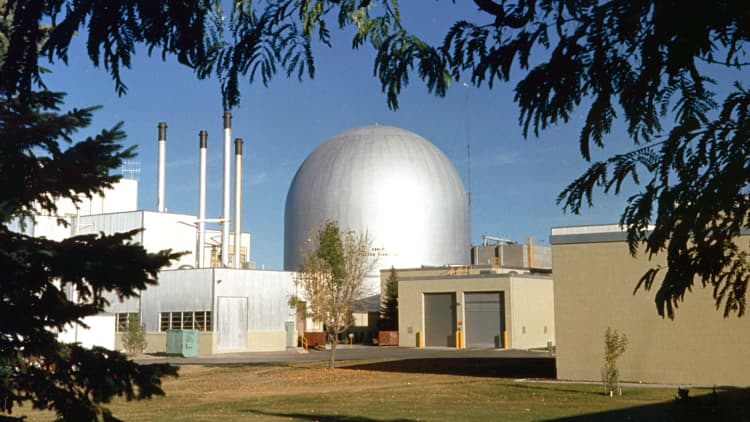
An artist rendering of the new Westinghouse AP300, a small modular reactor.
Artist rendering courtesy Westinghouse
Westinghouse is offering a smaller-scale nuclear reactor in an effort to expand access to nuclear power as demand for clean energy soars.
The company announced the launch of a small version of its flagship AP1000 nuclear reactor on Thursday. The new reactor, called the AP300, aims to be available in 2027, and will generate about a third of the power of the flagship AP1000 reactor.
Westinghouse’s move is a notable inflection point in the nuclear industry’s effort to remake itself as a way to address climate change. Electricity generated from a nuclear fission reactor produces no greenhouse gas emissions.
The AP300 will generate approximately 300 megawatts of energy, which will power approximately 300,000 homes, versus 1,200 megawatts for the AP1000, according to David Durham, president of energy systems at Westinghouse.
Smaller nuclear reactors are less expensive to build, which is a major selling point. The AP300 is estimated to cost approximately $1 billion per unit, Durham told CNBC. A 2022 study from MIT, which Durham cited to CNBC, estimates that it should cost around $6.8 billion to stand up an AP1000.
The Vogtle power plant in Georgia is adding two AP1000s, and that project has been widely criticized for budget and schedule overruns. But Durham says publicized cost estimates, which have reached past $30 billion, include things like interest on money borrowed to pay for the project.
Because the small modular reactors are smaller and less expensive, they are also more versatile.
“Unlike the previous generation of nuclear power plants, which were only used by large integrated utilities, the sizes of the advanced reactors which range from microreactors of a half-megawatt to 300 megawatts or more, means that there is a significantly larger number of utilities that can utilize these technologies,” Jeffrey S. Merrifield, a nuclear energy lawyer and former commissioner of the U.S. Nuclear Regulatory Commission, told CNBC. (News of Westinghouse’s AP300 was not public before Thursday morning, so Merrifield was speaking with CNBC about general trends in the nuclear industry.)
Small nuclear reactors are also being eyed by industrial producers as carbon-free sources of heat, Merrifield told CNBC.
“One aspect of many of the advanced reactor technologies, including high-temperature gas, molten-salt and sodium fast reactors, is they can produce industrial grade heat for non-power purposes or combined heat and power applications for industries such as steel making, chemical production, cement production, and milling and mining among many others,” Merrifield said.
It’s also easier to connect small reactors to the power grid. In the U.S., transmission lines are virtually tapped out. It can take years to get new sources of power connected because they often require an upgrade in transmission capacity. But an AP300 nuclear reactor will produce roughly the same amount of electricity as what a typical coal plant produces, so replacing one coal plant with a small nuclear reactor would be simpler.
For the AP300 to be available to customers at the end of 2027 in the U.S., the Nuclear Regulatory Commission will have to offer approval, but Durham said he’s confident that will happen.
“We have absolute confidence, because the NRC has already licensed every bit of this technology,” Durham told CNBC. “This is all the same exact thing.”

The AP300 also has the same safety features of the AP1000, Durham said. The passive cooling system is especially critical in both models.
Water keeps the fuel rods cool, preventing them from overheating. When a nuclear reactor shuts down, the fuel rods still need to be kept cool, which requires backup sources of electricity.
“And if you don’t have backup sources of electricity, or backup sources of water, then you can have a situation where the fuel overheats, like it did at Fukushima,” Durham said. “Passive safety systems keep the fuel cool all by themselves with no human action, no backup source of electricity, no backup source of water, because everything you need to keep the fuel cool is inside the reactor.”
In a passive cooling system, a large pool of water sits above the reactor. If the reactor needs to shut down, the water is released and falls onto the fuel rods. As the water heats up, it produces steam, which rises, condenses back into water and then keeps cycling for about three days, Durham said. At the end of three days, if the reactor still isn’t operating, more water needs to be added in the tank at the top of the reactor.
“This is a game changer technology,” he said. “If the AP1000 had been in operation at Fukushima, it would have been a total non-event.”
Demand for large nuclear reactors strong overseas
While small nuclear reactors are a new area of interest for the industry, demand for large reactors is still robust outside the U.S.
“In most countries, utilities are state owned,” Durham said. “If the country makes a commitment to decarbonize, then the utility is the vehicle to implement that decarbonization.”
In much of the U.S., the lowest-cost energy wins, and nuclear energy is not usually the cheapest.
There are two AP1000 reactors in the U.S. at the Vogtle power plant — one will be online later this year, the second by early 2024. But four are operating in China, and another six are under construction.
Westinghouse has an agreement to build nine AP1000s in Ukraine, has been selected to build three AP1000s in Poland, and is in the running for another 11 AP1000s throughout Europe, Durham told CNBC.
There’s also interest in large nuclear reactors from several more countries in Africa and Asia, including Egypt, Indonesia, Nigeria, the Philippines, Saudi Arabia and the United Arab Emirates, among others, according to Merrifield.
Larger reactors, while more expensive to build, will produce electricity at a cheaper price.
“SMRs will be very valuable, they will play an important role in many areas,” Durham said. “Their electricity will be slightly more expensive than larger units. And so if a country is looking for large baseload electricity generation carbon free, they typically will look at those larger units.”

